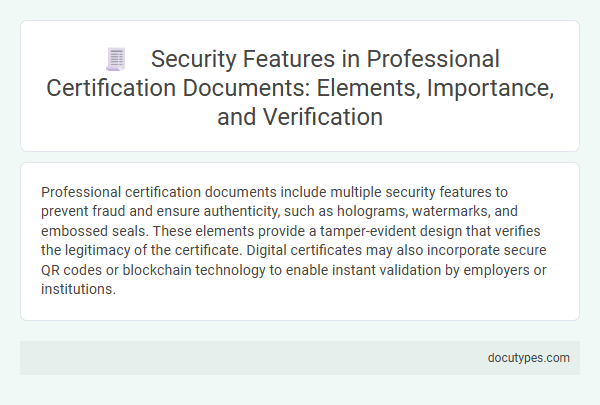Professional certification documents include multiple security features to prevent fraud and ensure authenticity, such as holograms, watermarks, and embossed seals. These elements provide a tamper-evident design that verifies the legitimacy of the certificate. Digital certificates may also incorporate secure QR codes or blockchain technology to enable instant validation by employers or institutions.
Introduction to Security Features in Certification Documents
| Introduction to Security Features in Certification Documents | |
|---|---|
| Purpose | Security features in professional certification documents protect against counterfeiting, tampering, and unauthorized duplication, ensuring the authenticity and integrity of the credentials issued. |
| Holograms | Embedded holographic images are difficult to replicate and provide a visually verifiable element that confirms the document's legitimacy. |
| Watermarks | Custom watermarks integrated into the paper serve as a background image visible under light, making duplication challenging. |
| Microprinting | Very small text printed on the document appears as a line to the naked eye but can be read under magnification, deterring forgery. |
| Serial Numbers | Unique serial or registration numbers track each certificate individually, allowing verification against issuing authority records. |
| UV Inks | Invisible under normal light, UV-sensitive inks reveal security patterns or text under ultraviolet lamps for authenticating documents. |
| Embossing and Raised Seals | Physical textures like embossed seals or raised stamps provide tactile verification that is difficult to fake. |
| Barcodes and QR Codes | Encoded data embedded through barcodes or QR codes links directly to the official certification database for rapid digital validation. |
| Your Role | You play a vital role in maintaining the security of your certification by verifying these features carefully when presenting or sharing your credentials. |
Key Elements of Secure Certification Documents
Professional certification documents include multiple security features to prevent fraud and ensure authenticity. Key elements such as holograms, watermarks, and embossed seals protect against counterfeiting. You can trust these features to safeguard the integrity of your certification credentials.
Importance of Security in Professional Certificates
Security features in professional certification documents play a critical role in ensuring the authenticity and credibility of your qualifications. Protecting these documents from forgery safeguards professional reputation and maintains industry standards.
- Holograms - Embedded holographic images provide a visually complex and tamper-proof element that is difficult to replicate.
- Watermarks - Invisible or semi-visible watermarks embedded in the paper add an extra layer of verification for authenticity checks.
- Serial Numbers - Unique serial or registration numbers enable precise tracking and validation of each certificate issued.
Maintaining these security features is essential to preserve the trust in professional certification systems.
Common Types of Security Features Used
Professional certification documents incorporate various security features to prevent counterfeiting and ensure authenticity. Common types include holograms, watermarks, microprinting, and embossed seals that make replication difficult.
Such features enhance the trustworthiness of your certification by verifying its legitimacy at a glance. Security threads, UV ink, and tamper-evident elements also contribute to protecting these official documents against fraud.
Digital vs Physical Security Measures
Professional certification documents incorporate advanced security features to prevent forgery and unauthorized duplication. Digital certificates utilize encryption, blockchain verification, and secure QR codes to ensure authenticity and easy online validation. Physical certificates rely on watermarks, holograms, embossed seals, and specialized paper to provide tangible proof of legitimacy and protection against counterfeiting.
Verification Processes for Authentic Certificates
What are the security features of professional certification documents that ensure authenticity?
Professional certification documents incorporate security elements such as watermarks, holograms, and microtext to prevent forgery. Verification processes often include online validation portals and QR codes that allow employers to instantly confirm the certificate's legitimacy.
Preventing Forgery and Counterfeiting
Professional certification documents incorporate advanced security features to prevent forgery and counterfeiting. These measures ensure the authenticity and integrity of the credentials issued to qualified individuals.
- Holograms - Embedded holographic images provide a difficult-to-replicate visual security element that verifies document legitimacy.
- Microprinting - Tiny printed text, invisible to the naked eye but clear under magnification, deters unauthorized duplication.
- Watermarks - Custom watermarks embedded in the paper substrate enhance protection by being challenging to forge or alter without detection.
Emerging Technologies in Certificate Security
Professional certification documents incorporate advanced security features to prevent fraud and ensure authenticity. Emerging technologies enhance these features, making certificates more reliable and tamper-resistant.
Blockchain technology creates immutable records that secure your certification data against alteration. QR codes and digital watermarks enable quick verification and protect against counterfeiting in real time.
Best Practices for Issuers and Recipients
Professional certification documents incorporate advanced security features to ensure authenticity and prevent fraud. Best practices guide issuers and recipients in maintaining the integrity of these credentials.
- Holograms and Watermarks - These embedded visual elements provide a unique and difficult-to-replicate layer of security against counterfeiting.
- Digital Certificates and QR Codes - Issuers integrate scannable codes linking to secure verification portals for instant validation of credentials.
- Secure Issuer Databases - Maintaining encrypted records allows issuers and recipients to confirm the legitimacy of certifications promptly and reliably.
What Are the Security Features of Professional Certification Documents? Infographic

